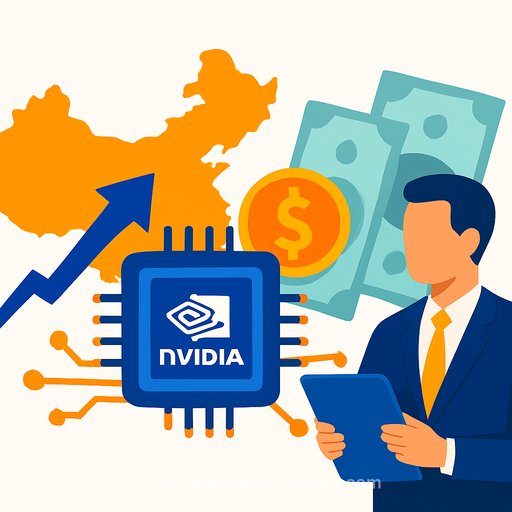Nvidia's Possible China Reentry: What Sales Teams Should Prepare For Now
There's movement on Nvidia's China story. Reports indicate the administration is weighing a path for Nvidia to sell H200 chips in China, which could add billions in revenue if it sticks.
Before you update your forecasts, know this: it's not done, and there are hurdles on both sides. Still, sales teams that prepare for either outcome will be faster to capture demand or redirect focus without losing momentum.
Quick context
- China accounted for 13% of Nvidia's 2024 revenue, or $17.1B.
- Nvidia previously sold a downgraded H20 to meet export rules, but new policy in April 2025 blocked those sales.
- A proposed deal to resume sales with a 15% revenue share didn't materialize after Beijing discouraged purchases on security grounds.
- H200 offers higher memory capacity and bandwidth than H100/H20-key for training large models and running inference at scale.
- Despite the China pause, Nvidia's fiscal Q3 2026 revenue hit $57B ($51.2B from data center), up 62% year over year, with Q4 guidance at $67B.
- Blackwell demand is intense and Rubin is slated next year, but approval to sell Blackwell into China is unlikely for now; H200 is the near-term lever-if allowed.
Why this matters for sellers
If H200 access opens, demand could be immediate, especially from AI training and inference-heavy buyers that hit ceilings with domestic chips. Expect interest across cloud providers, internet platforms, OEMs, and high-performance computing customers.
Even without China, Nvidia has momentum. The play is readiness: account mapping, messaging, and deal mechanics that you can deploy the moment policy shifts.
Two scenarios to plan for
- Scenario A: Conditional approval for H200 (possibly downgraded)
- Action: Pre-build pricing frameworks for base and downgraded SKUs. Model margins if a revenue share or compliance fee is required.
- Action: Draft compliance-forward proposals with export license steps, delivery lead times, and supply allocation rules.
- Action: Prepare ROI calculators that show throughput, time-to-train reductions, and total cost per token vs. domestic alternatives.
- Scenario B: No approval (status quo)
- Action: Shift pipeline toward regions and segments with confirmed supply. Lean into Blackwell-attached services and upgrades where permitted.
- Action: Compete against domestic China alternatives outside of China using performance-per-watt, rack density, and time-to-value.
- Action: Keep a live watchlist of export control updates to pivot quickly if policy shifts.
Account strategy checklist
- Identify top accounts with stalled AI roadmaps due to supply or policy limits. Map decision makers across infra, AI research, procurement, and compliance.
- Line up distributors and SI partners who can handle import, licensing, and deployment documentation.
- Create bilingual one-pagers: H200 vs. H20/H100 vs. Blackwell-position by workload (training vs. inference), memory footprint, and bandwidth needs.
- Prepare legal/compliance packets: export control notes, data residency language, delivery terms, and deal desk escalation paths.
- Forecast with ranges: conservative (no approval), base case (downgraded approval), upside (standard H200). Tie quotas to scenario gates, not guesses.
Messaging that will land
- Throughput and queue reduction: shorten model training cycles and increase experiment velocity.
- Lower cost per unit of compute: fewer nodes for the same job, less overhead, faster iteration.
- Compliance-first deployment: clear path on licensing, documentation, and support.
- Future-proofing: straightforward upgrade path as next-gen products arrive, without heavy refactoring.
Risks to surface early
- Policy reversals or added restrictions mid-deal.
- Potential downgrades that alter performance, pricing, and ROI.
- Buyer-side restrictions or guidance that favors domestic alternatives.
- Longer licensing timelines that impact go-live dates and penalties.
- FX and payment controls that affect terms and collections.
Signals to watch
- Official export control updates from the U.S. Department of Commerce's Bureau of Industry and Security.
- Any Nvidia announcements on China-specific SKUs or order windows.
- Procurement guidance from Chinese authorities and major cloud providers.
- Distributor stocking notices and lead-time changes.
Useful references
Skill up your team
If your reps sell AI infrastructure or services, sharpen technical fluency and objection handling now. It pays off the moment approvals change.
- AI courses by job role to improve buyer conversations and deal quality.
Bottom line: prepare for both outcomes. Have your accounts mapped, your compliance story tight, and your numbers modeled. If approval lands, you'll be first in the door. If it doesn't, you won't lose a quarter resetting your plan.
Your membership also unlocks:






